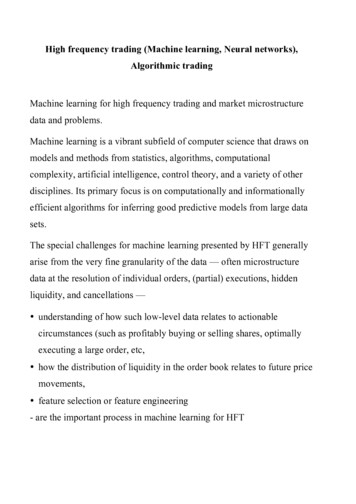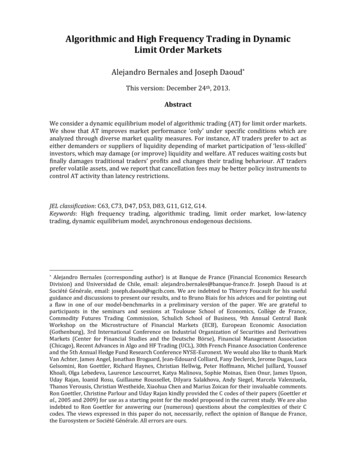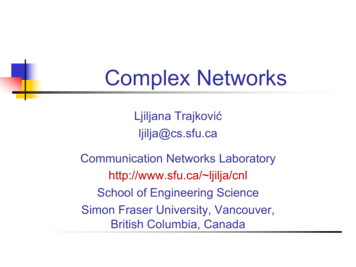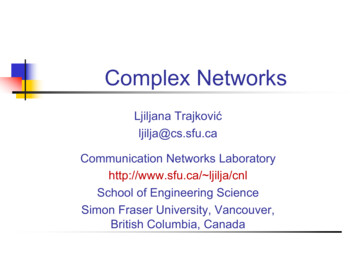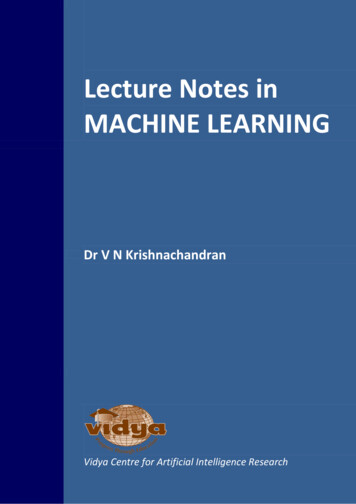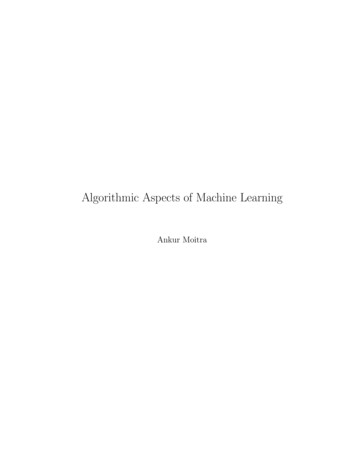
Transcription
Algorithmic Aspects of Machine LearningAnkur Moitra
ContentsContentsiPrefacev1 Introduction32 Nonnegative Matrix Factorization72.1Introduction . . . . . . . . . . . . . . . . . . . . . . . . . . . . . . . .2.2Algebraic Algorithms . . . . . . . . . . . . . . . . . . . . . . . . . . . 172.3Stability and Separability . . . . . . . . . . . . . . . . . . . . . . . . 262.4Topic Models . . . . . . . . . . . . . . . . . . . . . . . . . . . . . . . 352.5Exercises . . . . . . . . . . . . . . . . . . . . . . . . . . . . . . . . . . 433 Tensor Decompositions: Algorithms7453.1The Rotation Problem . . . . . . . . . . . . . . . . . . . . . . . . . . 463.2A Primer on Tensors . . . . . . . . . . . . . . . . . . . . . . . . . . . 48i
iiCONTENTS3.3Jennrich’s Algorithm . . . . . . . . . . . . . . . . . . . . . . . . . . . 553.4Perturbation Bounds . . . . . . . . . . . . . . . . . . . . . . . . . . . 623.5Exercises . . . . . . . . . . . . . . . . . . . . . . . . . . . . . . . . . . 724 Tensor Decompositions: Applications754.1Phylogenetic Trees and HMMs . . . . . . . . . . . . . . . . . . . . . . 764.2Community Detection . . . . . . . . . . . . . . . . . . . . . . . . . . 854.3Extensions to Mixed Models . . . . . . . . . . . . . . . . . . . . . . . 924.4Independent Component Analysis . . . . . . . . . . . . . . . . . . . . 1024.5Exercises . . . . . . . . . . . . . . . . . . . . . . . . . . . . . . . . . . 1085 Sparse Recovery1115.1Introduction . . . . . . . . . . . . . . . . . . . . . . . . . . . . . . . . 1115.2Incoherence and Uncertainty Principles . . . . . . . . . . . . . . . . . 1165.3Pursuit Algorithms . . . . . . . . . . . . . . . . . . . . . . . . . . . . 1205.4Prony’s Method . . . . . . . . . . . . . . . . . . . . . . . . . . . . . . 1245.5Compressed Sensing . . . . . . . . . . . . . . . . . . . . . . . . . . . 1295.6Exercises . . . . . . . . . . . . . . . . . . . . . . . . . . . . . . . . . . 1376 Sparse Coding1396.1Introduction . . . . . . . . . . . . . . . . . . . . . . . . . . . . . . . . 1406.2The Undercomplete Case . . . . . . . . . . . . . . . . . . . . . . . . . 144
CONTENTSiii6.3Gradient Descent . . . . . . . . . . . . . . . . . . . . . . . . . . . . . 1526.4The Overcomplete Case . . . . . . . . . . . . . . . . . . . . . . . . . 1596.5Exercises . . . . . . . . . . . . . . . . . . . . . . . . . . . . . . . . . . 1677 Gaussian Mixture Models1697.1Introduction . . . . . . . . . . . . . . . . . . . . . . . . . . . . . . . . 1707.2Clustering-Based Algorithms . . . . . . . . . . . . . . . . . . . . . . . 1757.3Discussion of Density Estimation . . . . . . . . . . . . . . . . . . . . 1817.4Clustering-Free Algorithms . . . . . . . . . . . . . . . . . . . . . . . . 1867.5A Univariate Algorithm . . . . . . . . . . . . . . . . . . . . . . . . . 1947.6A View from Algebraic Geometry . . . . . . . . . . . . . . . . . . . . 2007.7Exercises . . . . . . . . . . . . . . . . . . . . . . . . . . . . . . . . . . 2068 Matrix Completion2078.1Introduction . . . . . . . . . . . . . . . . . . . . . . . . . . . . . . . . 2088.2Nuclear Norm . . . . . . . . . . . . . . . . . . . . . . . . . . . . . . . 2128.3Quantum Golfing . . . . . . . . . . . . . . . . . . . . . . . . . . . . . 218Bibliography225
ivCONTENTS
PrefaceThe monograph is based on the class “Algorithmic Aspects of Machine Learning”taught at MIT in Fall 2013, Spring 2015 and Fall 2017. Thank you to all the students and postdocs who participated in this class, and made teaching it a wonderfulexperience.v
To Diana and Olivia, the sunshine in my life1
2CONTENTS
Chapter 1IntroductionMachine learning is starting to take over decision-making in many aspects of ourlife, including:(a) keeping us safe on our daily commute in self-driving cars(b) making an accurate diagnosis based on our symptoms and medical history(c) pricing and trading complex securities(d) discovering new science, such as the genetic basis for various diseases.But the startling truth is that these algorithms work without any sort of provableguarantees on their behavior. When they are faced with an optimization problem,do they actually find the best solution or even a pretty good one? When they posita probabilistic model, can they incorporate new evidence and sample from the trueposterior distribution? Machine learning works amazingly well in practice, but thatdoesn’t mean we understand why it works so well.3
4CHAPTER 1. INTRODUCTIONIf you’ve taken traditional algorithms courses, the usual way you’ve been ex-posed to thinking about algorithms is through worst-case analysis. When you havea sorting algorithm you measure it’s running time based on how many operationsit takes on the worst possible input. That’s a convenient type of bound to have,because it means you can say meaningful things about how long your algorithmtakes without ever worrying about the types of inputs you usually give it.But what makes analyzing machine learning algorithms — especially modernones — so challenging is that the types of problems they are trying to solve really areN P -hard on worst-case inputs. When you cast the problem of finding the parametersthat best fit your data as an optimization problem, there are instances where it isN P -hard to find a good fit. When you posit a probabilistic model and want to useit to perform inference, there are instances where that is N P -hard as well.In this book, we will approach the problem of giving provable guarantees formachine learning by trying to find more realistic models for our data. In manyapplications, there are reasonable assumptions we can make based on the context inwhich the problem came up, that can get us around these worst-case impedimentsand allow us to rigorously analyze heuristics that are used in practice, as well asdesign fundamentally new ways of solving some of the central, recurring problemsin machine learning.To take a step back, the idea of moving beyond worst-case analysis is anidea that is as old1 as theoretical computer science itself [95]. In fact there aremany different flavors of what it means to understand the behavior of algorithmson “typical” instances, including:1After all, heuristics performing well on real life inputs are old as well (long predating modernmachine learning) and hence so is the need to explain them.
5(a) probabilistic models for your input — or even hybrid models that combineelements of worst-case and average-case analysis like semi-random models [38,71] or smoothed analysis [39, 130](b) ways to measure the complexity of your problem, and ask for algorithms thatare fast on simple inputs, as in parameterized complexity [66](c) notions of stability that attempt to articulate what instances of your problemhave meaningful answers and are the ones you actually want to solve [20, 32]This is by no means an exhaustive list of topics or references. Regardless, in thisbook, we will approach machine learning problems armed with these sorts of insightsabout what are ways to get around intractability.Ultimately, we hope that theoretical computer science and machine learninghave a lot left to teach each other. Understanding why heuristics like expectationmaximization or gradient descent on a non-convex function work so well in practiceis a grand challenge for theoretical computer science. But to make progress on thesequestions, we need to understand what types of models and assumptions make sensein the context of machine learning. On the other hand, if we make progress on thesehard problems and develop new insights about why heuristics work so well, we canhope to engineering them better. We can even hope to discover totally new ways tosolve some of the important problems in machine learning, especially by leveragingmodern tools in our algorithmic toolkit.In this book, we will cover the following topics:(a) nonnegative matrix factorization(b) topic modeling
6CHAPTER 1. INTRODUCTION(c) tensor decompositions(d) sparse recovery(e) sparse coding(f) learning mixtures models(g) matrix completionI hope that more chapters will be added in later versions, as the field develops andmakes new discoveries.
Chapter 2Nonnegative Matrix FactorizationIn this chapter, we will explore the nonnegative matrix factorization problem. It willbe helpful to first compare it to the more familiar singular value decomposition. Inthe worst-case, the nonnegative matrix factorization problem is N P -hard (seriously,what else did you expect?) but we will make domain-specific assumptions (calledseparability) that will allow us to give provable algorithms for an important specialcase of it. We then apply our algorithms to the problem of learning the parametersof a topic model. This will be our first case-study in how to not back down in theface of computational intractability, and find ways around it.2.1IntroductionIn order to better understand the motivations behind the nonnegative matrix factorization problem and why it is useful in applications, it will be helpful to firstintroduce the singular value decomposition and then compare them. Eventually, we7
8CHAPTER 2. NONNEGATIVE MATRIX FACTORIZATIONwill apply both of these to text analysis later in this section.The Singular Value DecompositionThe singular value decomposition (SVD) is one of the most useful tools in linearalgebra. Given an m n matrix M , its singular value decomposition is written asM U ΣV Twhere U and V are orthonormal and Σ is a rectangular matrix with non-zero entriesonly along the diagonal and its entries are nonnegative. Alternatively we can writeM rXσi ui viTi 1where ui is the ith column of U , vi is the ith column of V and σi is the ith diagonalentry of Σ. Throughout this section we will fix the convention that σ1 σ2 . σr 0. In this case, the rank of M is precisely r.Throughout this course, we will have occasion to use this decomposition aswell as the (perhaps more familiar) eigendecomposition. If M is an n n matrixand is diagonalizable, its eigendecomposition is written asM P DP 1where D is diagonal. For now the important facts to remember are:(1) Existence: Every matrix has a singular value decomposition, even if it is
2.1. INTRODUCTION9rectangular. In contrast, a matrix must be square to have an eigendecomposition. Even then not all square matrices can be diagonalized, but a sufficientcondition under which M can be diagonalized is that all its eigenvalues aredistinct.(2) Algorithms: Both of these decompositions can be computed efficiently. Thebest general algorithms for computing the singular value decomposition run intime O(mn2 ) if m n. There are also faster algorithms for sparse matrices.There are algorithms to compute an eigendecomposition in O(n3 ) time andthere are further improvements based on fast matrix multiplication, althoughit is not clear whether such algorithms are as stable and practical.(3) Uniqueness: The singular value decomposition is unique if and only if itssingular values are distinct. Similarly, the eigendecomposition is unique if andonly if its eigenvalues are distinct. In some cases, we will only need that thenon-zero singular values/eigenvalues are distinct because we can ignore theothers.Two ApplicationsTwo of the most important properties of the singular value decomposition are thatit can be used to find the best rank k approximation, and that it can be used fordimension reduction. We explore these next. First let’s formalize what we mean bythe best rank k approximation problem. One way to do this is to work with theFrobenius norm:Definition 2.1.1 (Frobenius norm) kM kF qPi,j2Mi,j
10CHAPTER 2. NONNEGATIVE MATRIX FACTORIZATIONIt is easy to see that the Frobenius norm is invariant under rotations. For example,this follows by considering each of the columns of M separately as a vector. Thesquare of the Frobenius norm of a matrix is the sum of squares of the norms of itscolumns. Then left-multiplying by an orthogonal matrix preserves the norm of eachof its columns. An identical argument holds for right-multiplying by an orthogonalmatrix (but working with the rows instead). This invariance allows us to give analternative characterization of the Frobenius norm which is quite useful:TkM kF kU M V kF kΣkF qXσi2The first equality is where all the action is happening, and uses the rotationalinvariance property we established above.Then the Eckart-Young Theorem asserts that the best rank k approximationto some matrix M (in terms of Frobenius norm) is given by its truncated singularvalue decomposition:Theorem 2.1.2 (Eckart-Young) argmin kM BkF rank(B) kPki 1σi ui viTLet Mk be the best rank k approximation. Then from our alternative definition ofqPr2the Frobenius norm it is immediate that kM Mk kF i k 1 σi .In fact, the same statement – that the best rank k approximation to M is itstruncated singular value decomposition – holds for any norm that is invariant underrotations. As another application consider the operator norm:Definition 2.1.3 (operator norm) kM k maxkxk 1 kM xk
2.1. INTRODUCTION11It is easy to see that the operator norm is also invariant under rotations, and moreover kM k σ1 , again using the convention that σ1 is the largest singular value.Then the Eckart-Young Theorem with respect to the operator norm asserts:Theorem 2.1.4 (Eckart-Young) argmin kM Bk rank(B) kPki 1σi ui viTAgain let Mk be the best rank k approximation. Then kM Mk k σk 1 . As aquick check, if k r then σk 1 0 and the best rank k approximation is exact andhas no error (as it should). You should think of this as something you can do withany algorithm for computing the singular value decomposition of M – you can findthe best rank k approximation to it with respect to any rotationally invariant norm.In fact, it is remarkable that the best rank k approximation in many different normscoincides! Moreover the best rank k approximation to M can be obtained directlyfrom its best rank k 1 approximation. This is not always the case, as we will seein the next chapter when we work with tensors.Next, we give an entirely different application of the singular value decomposition in the context of data analysis, before we move on to applications of it in textanalysis. Recall that M is an m n matrix. We can think of it as defining a distribution on n-dimensional vectors, which we obtain from choosing one of its columnsuniformly at random. Further suppose that E[x] 0 – i.e. the columns sum to theall zero vector. Let Pk be the space of all projections onto a k-dimensional subspace.Theorem 2.1.5 argmax E[kP xk2 ] P PkPki 1ui uTiThis is another basic theorem about the singular value decomposition, thatfrom it we can readily compute the k-dimensional projection that maximizes the
12CHAPTER 2. NONNEGATIVE MATRIX FACTORIZATIONprojected variance. This theorem is often invoked in visualization, where one canvisualize high-dimensional vector data by projecting it to a more manageable, lowerdimensional subspace.Latent Semantic IndexingNow that we have developed some of the intuition behind the singular value decomposition we will see an application of it to text analysis. One of the centralproblems in this area (and one that we will return to many times) is given a largecollection of documents we want to extract some hidden thematic structure. Deerwester et al. [60] invented latent semantic indexing (LSI) for this purpose, and theirapproach was to apply the singular value decomposition to what is usually calledthe term-by-document matrix:Definition 2.1.6 The term-by-document matrix M is an m n matrix where eachrow represents a word, each column represents a document whereMi,j count of word i in document jtotal number of words in document jThere are many popular normalization conventions, and here we have chosen tonormalize the matrix so that each of its columns sums to one. In this way, we caninterpret each document as a probability distribution on words. Also in constructingthe term-by-document matrix, we have ignored the order in which the words occur.This is called a bag-of-words representation, and the justification for it comes from athought experiment. Suppose I were to give you the words contained in a document,but in a jumbled order. It should still be possible to determine what the document
2.1. INTRODUCTION13is about, and hence forgetting all notions of syntax and grammar and representinga document as a vector loses some structure but should still preserve enough of theinformation to make many basic tasks in text analysis still possible.Once our data is in vector form, we can make use of tools from linear algebra.How can we measure the similarity between two documents? The naive approach isto base our similarity measure on how many words they have in common. Let’s try:hMi , Mj iThis quantity computes the probability that a randomly chosen word w from document i and a randomly chosen word w0 from document j are the same. But whatmakes this a bad measure is that when documents are sparse, they may not havemany words in common just by accident because of the particular words each authorchose to use to describe the same types of things. Even worse, some documents couldbe deemed to be similar because both of them contain many of the same commonwords which have little to do with what the documents are actually about.Deerwester et al. [60] proposed to use the singular value decomposition of M tocompute a more reasonable measure of similarity, and one that seems to work betterwhen the term-by-document matrix is sparse (as it usually is). Let M U ΣV T andlet U1.k and V1.k be the first k columns of U and V respectively. The approach isto compute:TTMj ihU1.kMi , U1.kfor each pair of documents. The intuition is that there are some topics that occurover and over again in the collection of documents. And if we could represent each
14CHAPTER 2. NONNEGATIVE MATRIX FACTORIZATIONdocument Mi in the basis of topics then their inner-product in that basis wouldyield a more meaningful measure of similarity. There are some models – i.e. ahypothesis for how the data is stochastically generated – where it can be shown thatthis approach provable recovers the true topics [118]. This is the ideal interactionbetween theory and practice – we have techniques that work (somewhat) well, andwe can analyze/justify them.However there are many failings of latent semantic indexing, that have motivated alternative approaches. If we associate the top singular vectors with topicsthen:(1) topics are orthonormalHowever topics like politics and finance actually contain many words in common.(2) topics contain negative valuesHence if a document contains such words, their contribution (towards the topic)could cancel out the contribution from other words. Moreover a pair of documentscan be judged to be similar because of particular topic that they are both not about.Nonnegative Matrix FactorizationFor exactly the failings we described in the previous section, nonnegative matrixfactorization is a popular alternative to the singular value decomposition in manyapplications in text analysis. However it has its own shortcomings. Unlike the singular value decomposition, it is N P -hard to compute. And the prevailing approachin practice is to rely on heuristics with no provable guarantees.
2.1. INTRODUCTION15Definition 2.1.7 A nonnegative matrix factorization of inner-dimension r is a decompositionM AWwhere A is n r, W is r n and both are entry-wise nonnegative. Moreover let thenonnegative rank of M – denoted by rank (M ) – be the minimum r so that such afactorization exists.As we will see, this factorization when applied to a term-by-document matrix canfind more interpretable topics. Beyond text analysis, it has many other applicationsin machine learning and statistics, including in collaborative filtering and imagesegmentation. For now, let’s give an interpretation of a nonnegative matrix factorization specifically in the context of text analysis. Suppose we apply it to a termby-document matrix. Then it turns out that we can always put it in a convenientcanonical form: Let D be a diagonal matrix whereDj,j mXAi,ji 1And further suppose that each Dj,j 0. Thene AD 1 and Wf DW . ThenClaim 2.1.8 Set AeWf are entry-wise nonnegative and M AeWf(1) A,e and the columns of Wf each sum to one(2) The columns of AWe leave the proof of this claim as an exercise, but the hint is that property (2)follows because the columns of M also sum to one.
16CHAPTER 2. NONNEGATIVE MATRIX FACTORIZATIONHence we can without loss of generality assume that our nonnegative matrixfactorization M AW is such that the columns of A and the columns of W eachsum to one. Then we can interpret this factorization as follows: Each document isitself a distribution on words, and what we have found is:(1) A collection of r topics – the columns of A – that are themselves distributionson words(2) For each document i, a representation of it – given by Wi – as a convexcombination of r topics so that we recover its original distribution on wordsLater on, we will get some insight into why nonnegative matrix factorizationis N P -hard. But what approaches are used in practice to actually compute such afactorization? The usual approach is alternating minimization:Alternating Minimization for NMFInput: M Rm nOutput: M A(N ) W (N )Guess entry-wise nonnegative A(0) of dimension m rFor i 1 to NSet W (i) argminW kM A(i 1) W k2F s.t. W 0Set A(i) argminA kM AW (i) k2F s.t. A 0EndAlternating minimization is quite general, and throughout this course we will come
2.2. ALGEBRAIC ALGORITHMS17back to it many times and find that problems we are interested in are solved inpractice using some variant of the basic approach above. However, it has no provableguarantees in the traditional sense. It can fail by getting stuck in a locally optimalsolution that is much worse than the globally optimal one. In fact, this is inevitablebecause the problem it is attempting to solve really is N P -hard.However in many settings we will be able to make progress by working withan appropriate stochastic model, where we will be able to show that it converges toa globally optimal solution provably. A major theme in this course is to not takeheuristics that seem to work in practice for granted, because being able to analyzethem will itself provide new insights into when and why they work, and also whatcan go wrong and how to improve them.2.2Algebraic AlgorithmsIn the previous section, we introduced the nonnegative matrix factorization problemand described some of its applications in machine learning and statistics. In fact,(because of the algebraic nature of the problem) it is far from clear that there is anyfinite time algorithm for computing it in the worst-case. Here we will explore someof the fundamental results in solving systems of polynomial equations, and derivealgorithms for nonnegative matrix factorization from these.Rank vs. Nonnegative RankRecall that rank (M ) is the smallest value r such that M has a nonnegative matrixfactorization M AW with inner-dimension r. It is easy to see that the following
18CHAPTER 2. NONNEGATIVE MATRIX FACTORIZATIONis another, equivalent definition:Claim 2.2.1 rank (M ) is the smallest r such that there are r entry-wise nonnegaPtive rank one matrices {Mi } that satisfy M i Mi .We can now compare the rank and the nonnegative rank. There are of coursemany equivalent definitions for the rank of a matrix, but the most convenient definition to compare the two is the following:Claim 2.2.2 rank(M ) is the smallest r such that there are r rank one matricesP{Mi } that satisfy M i Mi .The only difference between these two definitions is that the former stipulates thatall of the rank one matrices in the decomposition are entry-wise nonnegative whilethe latter does not. Thus it follows immediately that:Fact 2.2.3 rank (M ) rank(M )Can the nonnegative rank of a matrix be much larger than its rank? We encouragethe reader to think about this question before proceeding. This is equivalent toasking whether for an entry-wise nonnegative matrix M , one can without loss ofgenerality require the factors in its rank decomposition to be entry-wise nonnegativetoo. It is certainly true for a rank one matrix, and turns out to be true for a ranktwo matrix too, but.In general, the nonnegative rank cannot be bounded by any function of therank alone. In fact, the relationship (or lack thereof) between the rank and thenonnegative rank is of fundamental importance in a number of areas in theoretical
2.2. ALGEBRAIC ALGORITHMS19computer science. Fortunately, there are simple examples that illustrate that thetwo parameters can be far apart:Example: Let M be an n n matrix where Mij (i j)2 .It is easy to see that the column space of M is spanned by the following three vectors 1 1 1 1 2 4 . , . , . . . . 1nn2Hence rank(M ) 3. (In fact, rank(M ) 3). However, M has zeros along the diagonal and non-zeros off of it. Furthermore for any rank one, entry-wise nonnegativematrix Mi , its pattern of zeros and non-zeros is a combinatorial rectangle – i.e. theintersection of some set of rows and columns – and it can be shown that one needsat least log n such rectangles to cover the non-zeros of M without covering any ofits zeros. Hence:Fact 2.2.4 rank (M ) log nA word of caution: For this example, a number of authors have incorrectly triedto prove a much stronger lower bound (e.g. rank (M ) n). In fact (and somewhatsurprisingly) it turns out that rank (M ) 2 log n. The usual error is in thinkingthat because the rank of a matrix is the largest r such that it has r linearly independent columns, that the nonnegative rank is the largest r such that there are rcolumns where no column is a convex combination of the other r 1. This is nottrue!
20CHAPTER 2. NONNEGATIVE MATRIX FACTORIZATIONSystems of Polynomial InequalitiesWe can reformulate the problem of deciding whether rank (M ) r as a problem offinding a feasible solution to a particular system of polynomial inequalities. Morespecifically, rank (M ) r if and only if:(2.1) M A W AW 0 0has a solution. This system consists of quadratic equality constraints (one for eachentry of M ), and linear inequalities that require A and W to be entry-wise nonnegative. Before we worry about fast algorithms, we should ask a more basic question(whose answer is not at all obvious):Question 1 Is there any finite time algorithm for deciding if rank (M ) r?This is equivalent to deciding if the above linear system has a solution, butdifficulty is that even if there is one, the entries of A and W could be irrational. Thisis quite different than, say, 3-SAT where there is a simple brute-force algorithm.In contrast for nonnegative matrix factorization it is quite challenging to designalgorithms that run in any finite amount of time.But indeed there are algorithms (that run in some fixed amount of time) todecide whether a system of polynomial inequalities has a solution or not in thereal RAM model. The first finite time algorithm for solving a system of polynomialinequalities follows from the seminal work of Tarski, and there has been a long line of
2.2. ALGEBRAIC ALGORITHMS21improvements based on successively more powerful algebraic decompositions. Thisline of work culminated in the following algorithm of Renegar:Theorem 2.2.5 [126] Given a system of m polynomial inequalities in k variables,whose maximum degree is D and whose bit complexity is L, there is an algorithmwhose running time is(nDL)O(k)and decides whether the system has a solution. Moreover, if it does have a solutionthen it outputs a polynomial and an interval (one for each variable) in which thereis only one root, which is the value of the variable in the true solution.Notice that this algorithm finds an implicit representation of the solution, since youcan find as many bits of the solution as you would like by performing binary searchfor the root. Moreover this algorithm is essentially optimal, and improving it wouldyield sub-exponential time algorithms for 3-SAT.We can use these algorithms to solve nonnegative matrix factorization andit immediately implies that there is an algorithm for deciding if rank (M ) rthat runs in exponential time. However the number of variables we would needin the naive representation is nr mr, one for each entry in A or W . So even ifr O(1), we would need a linear number of variables and the running time wouldstill be exponential. It turns that even though the naive representation uses manyvariables, there is a more clever representation that uses many fewer variables.
22CHAPTER 2. NONNEGATIVE MATRIX FACTORIZATIONVariable ReductionHere we explore the idea of finding a system of polynomial equations that expressesthe nonnegative matrix factorization problem using many fewer variables. In [13,112], Arora et al. and Moitra gave a system of polynomial inequalities with f (r) 2r2 variables that has a solution if and only if rank (M ) r. This immediatelyyields a polynomial time algorithm to compute a nonnegative matrix factorizationof inner-dimension r (if it exists) for any r O(1). These algorithms turn out tobe essentially optimal in a worst-case sense, and prior to this work the best knownalgorithms even for the case r 4 ran in exponential time.We will focus on a special case, to illustrate the basic idea behind variablereduction. Suppose that rank(M ) r, and our goal is to decide whether or notrank (M ) r. This is called the simplicial factorization problem. Can we find analternate system of polynomial inequalities that expresses this decision problem butuses many fewer variables? The following simple but useful observation will pavethe way:Claim 2.2.6 In any solution to the simplicial factorization
The monograph is based on the class \Algorithmic Aspects of Machine Learning" taught at MIT in Fall 2013, Spring 2015 and Fall 2017. . pricing and trading complex securities (d)discovering new science, such as the genetic basis for various diseases. . In this book, we will a

